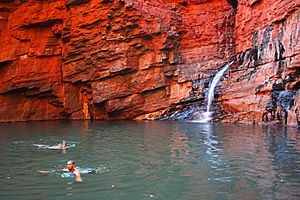Archaean facts for kids
Orange labels: known ice ages.
Also see: Human timeline and Nature timeline
The Archaean Eon is a super old time in Earth's history. It's like a huge chapter in our planet's story, lasting from about 4 billion years ago to 2.5 billion years ago. This eon comes after the Hadean Eon and before the Proterozoic Eon. During the Archaean, Earth started to look more like it does today, with oceans and the first signs of life.
Contents
Earth's Early Days
The Archaean Eon is one of the four main time periods, called eons, that make up Earth's long history. It began 4,000 million years ago (that's 4 billion years!) and ended 2,500 million years ago (2.5 billion years). This was a time when our planet was still very hot and active.
Hot Planet, Moving Plates
When the Archaean Eon started, Earth was much hotter than it is now. The heat flowing from inside the Earth was almost three times higher than today. Even when the Archaean ended, it was still twice as hot. This huge amount of heat likely made plate tectonics work much faster and stronger than it does today. Plate tectonics is the process where Earth's outer layer is broken into large pieces, or plates, that slowly move around. Scientists are still studying exactly when this process began.
Ancient Continents and Oceans
During the Archaean, the first large supercontinent called Vaalbara started to form. A supercontinent is a huge landmass made up of many smaller continents joined together. There were already oceans on Earth even before the Archaean Eon began. These oceans were very important for the development of early life.
Atmosphere and Early Life
The air during the Archaean Eon was very different from what we breathe today. It had almost no free oxygen. Instead, it was mostly made of gases like methane and carbon dioxide.
First Signs of Life
The Archaean Eon is special because it's when we find the first fossils of life forms. These early life forms were tiny bacteria, especially a type called cyanobacteria. We also find fossils of acritarchs, which were simple, single-celled organisms.
Stromatolites and Oxygen
One of the most important signs of early life are fossilized bacterial mats called stromatolites. These dome-shaped structures are found throughout the Archaean rocks, starting around 3,500 million years ago. Stromatolites were built by cyanobacteria. These tiny organisms used photosynthesis, a process that uses sunlight to make food. A key byproduct of photosynthesis is oxygen.
Initially, the oxygen released by cyanobacteria didn't go into the air. Instead, it combined with iron in the oceans, forming rust-like minerals. This is why many Archaean rocks are reddish. It took a very long time for enough oxygen to build up in the oceans and then start filling the atmosphere.

Ancient Raindrops
Scientists have even found fossilized raindrop marks from the later part of the Archaean Eon, about 2,700 million years ago. These amazing rock formations were discovered in the 1980s in Ventersdorp, located in the North West Province of South Africa. They give us a tiny glimpse into what the weather might have been like billions of years ago!

